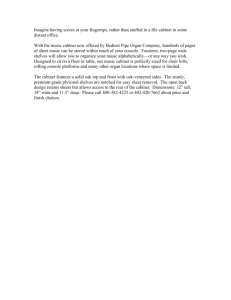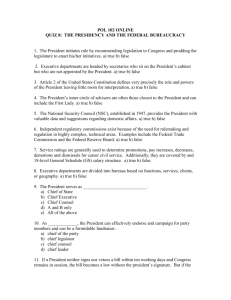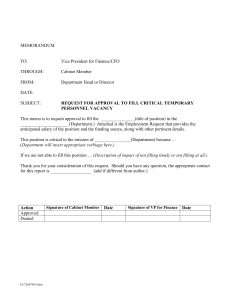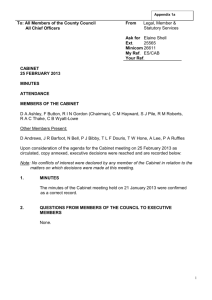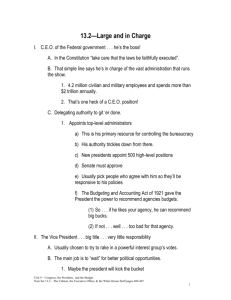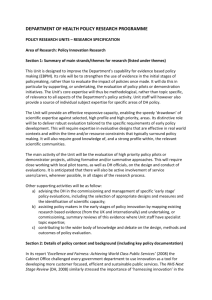Cabinet - kveritasushistory
advertisement
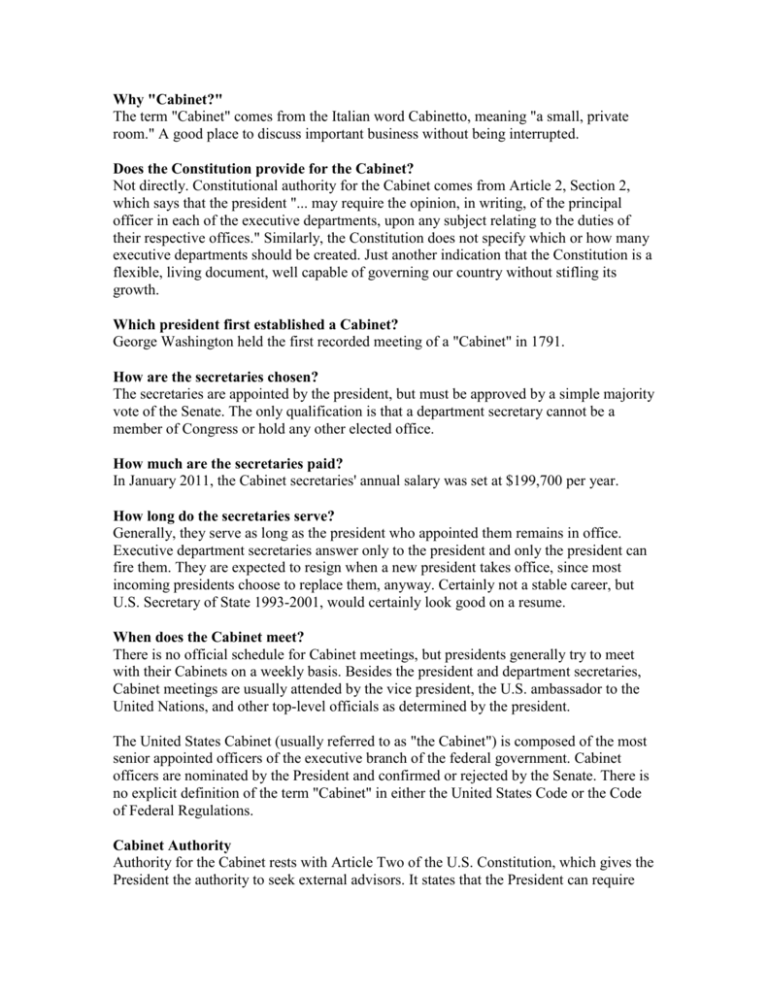
Why "Cabinet?" The term "Cabinet" comes from the Italian word Cabinetto, meaning "a small, private room." A good place to discuss important business without being interrupted. Does the Constitution provide for the Cabinet? Not directly. Constitutional authority for the Cabinet comes from Article 2, Section 2, which says that the president "... may require the opinion, in writing, of the principal officer in each of the executive departments, upon any subject relating to the duties of their respective offices." Similarly, the Constitution does not specify which or how many executive departments should be created. Just another indication that the Constitution is a flexible, living document, well capable of governing our country without stifling its growth. Which president first established a Cabinet? George Washington held the first recorded meeting of a "Cabinet" in 1791. How are the secretaries chosen? The secretaries are appointed by the president, but must be approved by a simple majority vote of the Senate. The only qualification is that a department secretary cannot be a member of Congress or hold any other elected office. How much are the secretaries paid? In January 2011, the Cabinet secretaries' annual salary was set at $199,700 per year. How long do the secretaries serve? Generally, they serve as long as the president who appointed them remains in office. Executive department secretaries answer only to the president and only the president can fire them. They are expected to resign when a new president takes office, since most incoming presidents choose to replace them, anyway. Certainly not a stable career, but U.S. Secretary of State 1993-2001, would certainly look good on a resume. When does the Cabinet meet? There is no official schedule for Cabinet meetings, but presidents generally try to meet with their Cabinets on a weekly basis. Besides the president and department secretaries, Cabinet meetings are usually attended by the vice president, the U.S. ambassador to the United Nations, and other top-level officials as determined by the president. The United States Cabinet (usually referred to as "the Cabinet") is composed of the most senior appointed officers of the executive branch of the federal government. Cabinet officers are nominated by the President and confirmed or rejected by the Senate. There is no explicit definition of the term "Cabinet" in either the United States Code or the Code of Federal Regulations. Cabinet Authority Authority for the Cabinet rests with Article Two of the U.S. Constitution, which gives the President the authority to seek external advisors. It states that the President can require "the Opinion, in writing, of the principal Officer in each of the executive Departments, upon any Subject relating to the Duties of their respective Offices." Congress, in turn, determines the number and scope of executive Departments. Qualifications For Cabinet Officers A cabinet officer cannot be a member of Congress or a sitting Governor. From Article One of the U.S. Constitution: "no person holding any office under the United States, shall be a member of either house during his continuance in office." This is why sitting Governors, Senators and members of the House of Representatives must resign before becoming a cabinet officer. The Emoluments Clause (U.S. Constitution, Article I, Section 9, Clause 8) bars any Congress member from holding any executive office that was created by law while s/he was serving in Congress. Parenthetically, the clause also forbids the United States from granting titles of nobility. Selection of Cabinet Officers The President nominates cabinet officers, who are presented to the United States Senate for confirmation or rejection on a simple majority vote. If approved, they are sworn in and begin their duties. Composition of The Cabinet With the exception of the Attorney General, all cabinet heads are called "Secretary." The modern cabinet includes the Vice President and the heads of 15 executive departments. In addition, five other individuals have cabinet rank. The Secretary of State is the highest ranking cabinet official; this Secretary is fourth in succession to the Presidency. Cabinet officers are titular heads of the permanent executive agencies of the government: Agriculture Commerce Defense Education Energy Interior Justice Labor Health and Human Services Homeland Security Housing and Urban Development State Transportation Treasury Veterans Affairs History of The Cabinet The Presidential Cabinet dates to the first American President, George Washington. He appointed a Cabinet of four people: Secretary of State, Thomas Jefferson; Secretary of the Treasury, Alexander Hamilton; Secretary of War, Henry Knox; and Attorney General, Edmund Randolph. Even today, the big four -- Secretary of State, Secretary of the Treasury, Secretary of Defense and Attorney General -- are the most important members of the President's Cabinet. President Franklin Roosevelt acted more through the Executive Office of the President or the National Security Council than the did through the Cabinet. The power of the noncabinet officers is evident in having additional "cabinet rank" staff, which includes the Vice President, the White House Chief of Staff, the heads of Environmental Protection Agency, Office of Management and Budget, Office of National Drug Control Policy, and the U.S. Trade Representative. Line of Succession The Cabinet is an important part of the presidential line of succession, which is the process that determines who may become or act as President of the United States upon the incapacity, death, resignation, or removal from office of a sitting president or a president-elect. The presidential line of succession is enumerated in the Presidential Succession Act of 1947 as amended. Because of this, it is common practice not to have the entire Cabinet in one location, even for ceremonial occasions like the State of the Union Address. This person is the designated survivor, and they are held at a secure, undisclosed location, ready to take over if the President, Vice President, and the rest of the Cabinet are killed. 1. Vice President 2. Speaker of the House of Representatives 3. President Pro Tempore of the Senate 4. Secretary of State 5. Secretary of the Treasury 6. Secretary of Defense 7. Attorney General 8. Secretary of the Interior 9. Secretary of Agriculture 10. Secretary of Commerce 11. Secretary of Labor 12. Secretary of Health and Human Services 13. Secretary of Housing and Urban Development 14. Secretary of Transportation 15. Secretary of Energy 16. Secretary of Education 17. Secretary of Veterans Affairs 18. Secretary of Homeland Security
